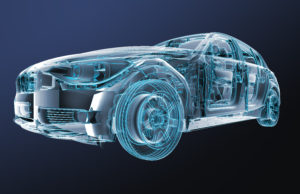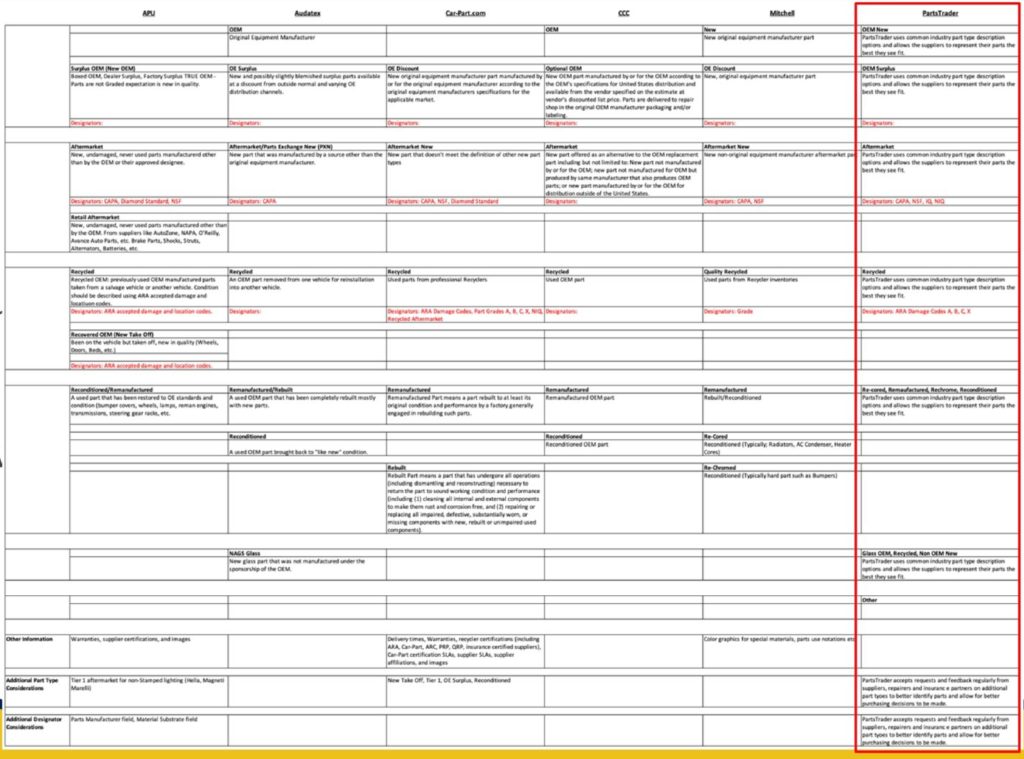
Auto body parts category definitions: Audatex, CCC, Mitchell
By onAssociations | Business Practices | Education | Market Trends | Repair Operations | Technology
The three estimating systems are close but not entirely in sync on parts category definitions, based on information shared last month by the Collision Industry Conference.
The classifications provided to the Parts and Materials Committee by Audatex, CCC and Mitchell educate repairers and insurers about what an estimate suggests would be installed and provide a sense of where greater industry consistency might be needed.
APU, Car-Part.com and PartsTrader also shared terminology with the CIC committee, and Mitchell content management senior director Jerry Gastineau noted during the July 22 CIC that all six companies involved in the discussion “sort of have a different definition” of the same types of parts. Hopefully, a “fruitful dialogue” would ensue, he said.
Here’s the estimating system definitions (minor edits) from a slide prepared by the CIC Parts and Materials Committee, as well some further discussion from the virtual CIC event.
Audatex
OEM: Original Equipment Manufacturer.
OE Surplus: New and possibly slightly blemished surplus parts available at a discount from outside normal and varying OE distribution channels.
Aftermarket/Parts Exchange New (PKN): New part that was manufactured by a source other than the original equipment manufacturer. (Designators: CAPA)
Recycled: An OEM part removed from one vehicle for reinstallation into another vehicle.
Remanufactured/Rebuilt: A used OEM part that has been completely rebuilt mostly with new parts.
Reconditioned: A used OEM part brought back to “like new” condition.
Eric Marrello, director of sales for sister Solera company APU, also served to represent Audatex at the July 22 CIC. His comments and the committee’s slides showed the two companies differed on some parts categories.
Audatex defines both an OEM part and OE Surplus. But while Audatex will consider “New and possibly slightly blemished surplus parts available at a discount from outside normal and varying OE distribution channels” as OE Surplus, APU only will call a part Surplus OEM if it’s new, “in the box,” and sold by a dealer or affiliate with “that warranty.”
Audatex also lacks APU’s Recovered OE class of parts, a designation for components removed from a brand-new vehicle. (For example, selling a headlight off of a vehicle within a showroom.) However, it segments refurbished parts more than APU does. Rather than a single definition for Reconditioned/Remanufactured parts like APU, Audatex defines Remanufactured/Rebuilt as “A used OEM part that has been completely rebuilt mostly with new parts,” but also recognizes Reconditioned parts: “A used OEM part brought back to ‘like new’ condition.” according to the slide.
CCC
OEM
Parts and Materials Committee Co-Chairman Ken Weiss (formerly of SSF Imported Auto Parts), said CCC uses the term OEM but didn’t define it to the committee.
Optional OEM: New OEM part manufactured by or for the OEM according to the OEM’s specifications for United States distribution and available from the vendor specified on the estimate at vendor’s discounted list price. Parts are delivered to repair shop in the original OEM manufacturer packaging and or labeling.
Aftermarket: New part offered as an alternative to the OEM replacement part including but not limited to: New part not manufactured by or for the OEM; new part not manufactured for OEM but produced by same manufacturer that also produces OEM pars; or new part manufactured by or for the OEM for distribution outside of the United States.
Recycled: Used OEM part.
Remanufactured: Remanufactured OEM part.
Reconditioned: Reconditioned OEM part.
CCC provided parts definitions to the committee but did not participate in the July 22 panel.
Mitchell
New: New original equipment manufacturer part.
OE Discount: New, original equipment manufacturer part.
Gastineau said Mitchell used the same definition for a new OEM part and an OE Discount. It was “pretty straightforward,” he said.
Aftermarket New: New non-original equipment manufacturer aftermarket part. (Designators: CAPA, NSF)
Quality Recycled: Used parts from Recycler inventories. (Designators: Grade)
Remanufactured: Rebuilt/Reconditioned.
Re-Cored: Reconditioned. Typically: radiators, AC condenser, heater cores.
Re-Chromed: Reconditioned. Typically hard part such as Bumpers.
Asked about a take-off part like APU’s Recovered OEM category, Gastineau said, “That’s a great question.” He said that as an information provider, Mitchell’s data focused on how a part was serviced and providing OEM part numbers. As take-off parts weren’t represented in the Mitchell database, “it isn’t clear” where they would fit, he said.
This shows the need for the conversation, Gastineau said.
Gastineau said he felt the entire industry “wants us to come together and align on what to call these parts.” He said Mitchell had an appetite for accepting accountability and adherence to definitions. Once everyone agreed on parts terms, the next step would be for everyone to align around them, he said.
More information:
CIC, July 22, 2020
Images:
The three estimating systems are close but not entirely in sync on parts category definitions, based on information shared July 22, 2020, by the Collision Industry Conference. (posteriori/iStock)
This graphic from the Collision Industry Conference Parts and Materials Committee outlines part category definitions outlined by estimating and part procurement systems. (Provided by Collision Industry Conference)

